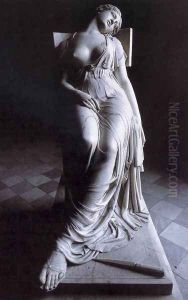Damian Campeny Y Estany Paintings
Damian Campeny y Estany was a distinguished Spanish sculptor born on December 12, 1771, in Sant Feliu de Llobregat, Catalonia. He was one of the most prominent figures in the Neoclassical art movement in Spain. Campeny showed an early talent for sculpture, and his skills were honed at the Escola de la Llotja in Barcelona, where he studied under notable teachers.
After his initial education, Campeny's talent was recognized, and he was awarded a scholarship to continue his studies in Rome. This opportunity allowed him to immerse himself in the classical antiquities and the works of Renaissance masters, which greatly influenced his artistic style. He spent a significant period in Italy, which was customary for artists of the era, who sought to study the masterpieces of classical antiquity and the Italian Renaissance firsthand.
Campeny returned to Spain and became a highly respected artist, contributing significantly to the Neoclassical movement within the country. He achieved considerable acclaim with his refined sculptures that often depicted mythological themes, historical figures, and religious subjects. His works were characterized by their smooth lines, attention to detail, and adherence to classical ideals of beauty and proportion.
In addition to his artistic creations, Campeny played an important role in the academic world. He served as the director of the sculpture department at the Escola de la Llotja, where he had once been a student. In this capacity, he influenced many young artists and helped to shape the direction of Spanish sculpture during the early to mid-19th century.
Campeny's legacy includes numerous works that are still admired today. Among his most famous sculptures is the marble group 'The Death of Lucretia,' which reflects his mastery of form and emotion. His works can be found in various locations, including the Museu Nacional d'Art de Catalunya in Barcelona.
Damian Campeny y Estany passed away on June 17, 1855, in Barcelona. His contributions to the Neoclassical style and his influence on subsequent generations of Spanish artists secure his place in the annals of art history. His meticulous approach to sculpture and his dedication to teaching have left a lasting imprint on the cultural heritage of Spain.
